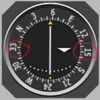Or a checkride. Out of Burlington. With a DPE who reportedly loves that there's a DME arc to fly.

Yep, that's why I mentioned a checkride. There really aren't too many choices for a realistic non-precision approach around us, given the equipment you are flying. I know some of the DPEs like using either the ILS or LOC at BUY or TTA with a pretend "Glideslope Unreliable" NOTAM, but the only realistic ones near us would the at RDU and GSO.
I just replotted this in Foreflight. It's 068 heading from LIB to STASE, then turn left 324. That's 104 degrees, so the initial question is still up in the air. The advice I hear on the internets is to turn 90 and adjust afterwards. I can do that, but I dislike the ambiguity.
I am not sure how you came up with 068 from LIB to STASE.
@sarangan I think can account for it.
Brian, remember, this is a
VOR approach, not a GPS approach. VORs are calibrated periodically to match magnetic heading but not often and they can be wayyyy off
*. This approach involves the 056°
Radial, not a GPS or other determination of the actual magnetic bearing from waypoint LIB to waypoint STASE. As Sarangan said, there are only two choices, one of which joins the arc and one of which turns away from it. If the VOR OBS or HSI course needle is on 056, there's nothing to calculate because it's just a right angle to the centered needle.
The discrepancy between VOR and what GPS (or Foreflight) will show is important to remember. I know of someone who failed an instrument checkride at your school on this approach because of it. I don't know the applicant but their CFII asked me what happened - they didn't realize it either!
Basically, there is no ambiguity to account for. Don't overcomplicate this simple approach. All that's involved with this one is the OBS set on 056, the needle centering, turning 90° to the centered needle and adjusting to maintain the 27 NM distance until ready to turn inbound on the FAC.
Edit: Looks like LIB was last set in 1963 based on a 3°W magnetic variation. There's 4° right there. And don't forget that a VOR can be up to 6° off.




